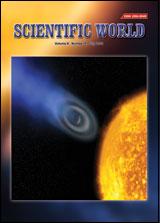Study of the Flux Density Variation In and Around the Planet Jupiter using 16" LX200GPS Schmidt-Cassegrain Telescope at the National Observatory, Nagarkot, Nepal
DOI:
https://doi.org/10.3126/sw.v8i8.3838Keywords:
Observation, Telescope, Jupiter, Flux densityAbstract
We present a study of relative flux density in and around the planet Jupiter using images taken from National Observatory located at Nagarkot, Nepal during the period from November, 2008 and January, 2010. For this Meade 16 inch LX200GPS Schmidt-Cassegrain telescope is used. We processed the image in the software ALADIN2.5. The values of relative flux density of 2,50,000 pixels are used for the study. At first, the observed two-dimensional image of the planet is divided into four quadrants. Each quadrant is subdivided into three sections. We studied the variation of relative flux density along 12 directions. The relative flux density per pixel is found to lie in the range 138.17 to 157.36. The maximum value of relative flux density per pixel is found along the eastern direction and the minimum value is found along the northern direction. Thus the absorption feature is found to be prominent along the northern direction. The emission of less amount of flux from the second quadrant is due to the absorption by the materials in this section. In addition, the role of the inhomogeneous absorption by the on-going gravitational contraction in the planet cannot be identified. Due to the inhomogeneous absorption feature, we studied the outer contours of all sections. The values of total amount of flux per pixel in the outer layers of the first, second, third and fourth quadrants are found to be 81.79, 82.37, 82.44 and 82.49 respectively. Surprisingly, this value is found to be least in the first quadrant. This suggests that the outer part is found to be selective whereas the inner part is emissive.
Key-words: Observation; Telescope; Jupiter; Flux density.
DOI: 10.3126/sw.v8i8.3838 Scientific World Vol.8(8) 2010 pp.4-9




